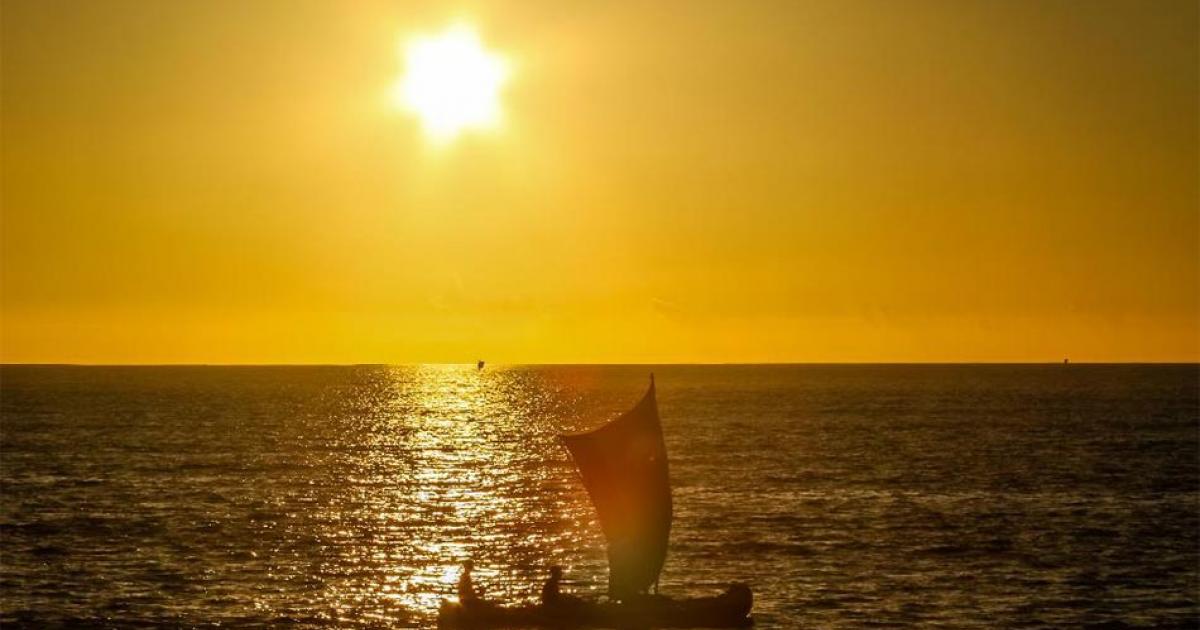
Ancient Mariners: Transoceanic Voyages Before the Europeans
The idea that humans have been completing transoceanic voyages - traveling the earth via our oceans - before Europeans set sail is, in many people's eyes, an accepted conclusion. Yet it is still debated, resisted, and rejected in many academic circles.
We have seen the work of Hapgood, who theorized a pre-ice age tradition of world mapping which involved an advanced, unknown sea-faring civilization who possessed astonishing abilities. Hapgood based these claims on decades of research into ancient map fragments; the most famous of which, the “Piri Reis” map dating to the 15th century, is believed by him and his team to show the Princess Martha Coast of Queen Maud Land Antarctica and the Palmer Peninsula.
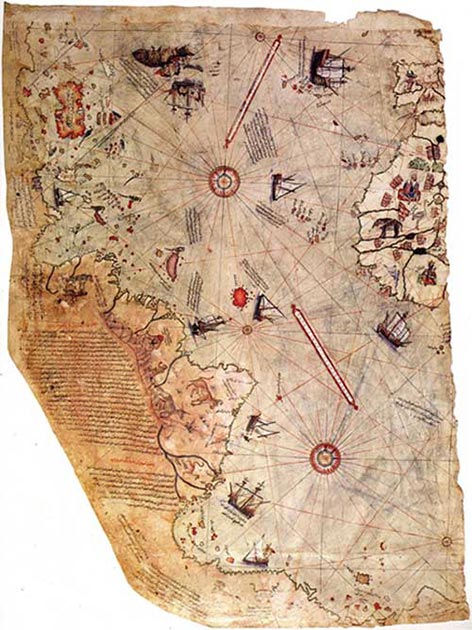
Map of the world by Ottoman admiral Piri Reis, drawn in 1513 but allegedly based on much older maps. (Public Domain)
Astonishing in itself, the fact that the fragment also appears to show the coastline free of ice is downright spectacular considering, according to research presented by Hapgood, the last time it was ice free was over 6,000 years ago (Hapgood, 1966, P. 93-98). Thus, when we consider an oceanic link say, between South America and the Pacific Islands, it should not be too hard to fathom.
In the realm of physical testing, a famous 1947 expedition saw Norwegian adventurer and ethnographer Thor Heyerdahl set off from Peru to French Polynesia in nothing more than a raft designed and constructed using local materials and techniques.
- Evidence Accumulates for Ancient Transoceanic Voyages, Says Geographer
- Amerigo Vespucci: The Forgotten Explorer Who Named America
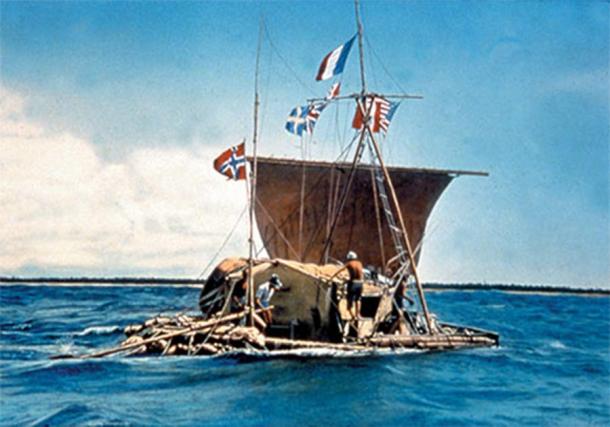
The Kon-Tiki Expedition Across the Pacific Ocean by balsa wood raft (1947). (cesar harada/CC BY NC SA 2.0)
Yes, Heyerdahl’s journey was a crazy one. Having based most hopes of survival on descriptions of traditional ancient crafts from the indigenous people, the intrepid sea-going adventurer and his five man crew were aiming to prove that trans-oceanic voyages from South America to the Pacific Islands was possible and, after 101 days in treacherous Pacific currents, sailing over 8,000 kilometers (5,000 miles) through barren stretches of nothing but water for as far as the eye can see, the washed-out crew finally broke land in the Tuamotus archipelago in French Polynesia, proving once and for all this trans-Pacific travel was indeed possible.
Heyerdahl’s journey was undisputable. The fact that his boat was constructed in the most basic manner possible simply adds to the notion that even at its most simple form, the notion of trans-oceanic voyage should not be dismissed.
Heyerdahl’s theories on how the people of the Pacific Islands arrived via migration from South America, however, was disputed. Nevertheless, this was in the mid-20th Century and, as of 2014, the U.K’s Independent reported findings that may add support to some of Heyerdahl’s long-put down theory. The discovery of two ancient skulls in Brazil, specifically linked to the indigenous Botocudo peoples, provided the opportunity for genetic testing to be carried out by the Natural History Museum of Denmark; and the results, published in a peer-reviewed journal, suggest the skulls’ “genomic ancestry is Polynesian, with no detectable Native American component” (Malaspinas, A. S. et al., 2014).
While the possibility that the genetic make-up of skulls was due to “mediated European transport,” the true age of the genetic lineage remains unclear. I believe this may in fact hint to what Heyerdahl had claimed all those decades before - a pre-European expansion across the Pacific.
On the Trail of Early Trans-Pacific Voyagers
If we were to ask: who could have been sailing at this distant time? - evidence like the “Gwion Gwion” rock art of the Kimberley region, located in the isolated western side of Australia, certainly depicts indigenous people using small boats to pass over open stretches of water. Heyerdahl showed that in this manner they could undergo long-distances.
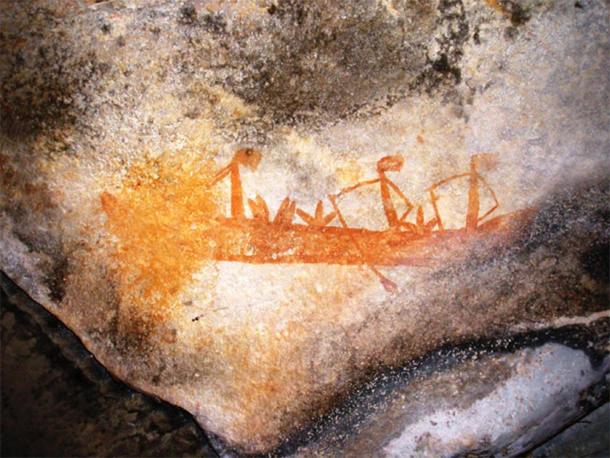
“Gwion Gwion” rock art depicting a boat, Kimberley, Australia. (Classconections)
This still does not explain the advanced map fragments. Accurate enough to be better than almost all “modern” maps pre-1900, we see no real evidence for writing-based systems in most of these subsistence-living style cultures who utilized small, human-powered boats. These ancient maps required expertise in the skills of geometry, geography, and a system to efficiently log all of this information.
The skills needed to create these maps must have come from somewhere, but where?
In my previous article, I discussed the fleeting possibility that the Acropolis' initial habitation and construction phases were actually the result of an ancient sea-faring culture, one that many contemporary independent researchers have been on the trail of for years, one who was not only at the heart of the archaic Greek's civilizations during their "golden age", but at the hearts of civilizations across the world - linking North Africa from Egypt to the Anatolian plains through Gobekli Tepe, out through Eurasia by way of Siberia into Europe, and far beyond.
Coincidentally, early 19th century travelers like the English-born doctor and ethnographer Edward Shortland recorded many of the Polynesian and Pacific Island foundation myths (specifically those from New Zealand and Cook Islands Māori population, the Tuamotu archipelago, and Marquesan in French Polynesia) and the locals all tell of how their own sea-faring cultures were created with the help of a first man: “Tiki”. One local told how:
“Tiki taught laws to regulate work, slaying, man-eating: from him men first learnt to observe laws for this thing, and for that thing, the rites to be used for the dead… and other invocations very numerous.” (Shortland, 1882, P. 2)
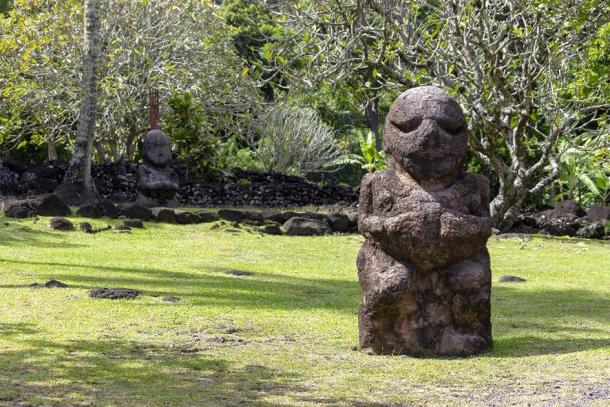
French Polynesia Tahiti Carved Stone Tiki Statue. (Tom Nast/Adobe Stock)
While the name changes somewhat, the figures description remains similar whatever island you end up on. Being symbolically connected to the water, Tiki is in the same vein as Oannes in the Middle East, Manu in the Indian subcontinent, Osiris and his followers in North Africa and Quetzalcoatl and Viracocha in the Americas, and the list could keep going on.
It is certainly curious that during the aforementioned Danish study, further testing of over 27 native Rapanui (Easter Islanders) DNA had concluded the genomes were on average about eight percent Native American, suggesting at one time the Rapanui and Native American people had been close in contact.
Again, it is hard to know whether this genetic link was pre or post-European voyage, but maybe certain stone figures from the Pacific Islands - aside from the now world-renowned Easter Island heads - smaller, lesser known sculptures, may hold a clue to where this connection spread from.

The now world-famous, gigantic Easter Island “Moai” heads - most are accompanied with even larger bodies buried under the ground. (Public Domain)
Stories Set in Stone
Many countries situated around the Pacific Ocean seem to draw parallels with one another, suggesting at one time there was at least one common connection between these amazing yet still so unknown settlements. This can also be seen throughout ancient sculpture.
The meaning behind the “dogu” is still unclear, but it is known that these mysterious Neolithic stone figurines appeared during the Jomon Period within ancient Japan, a strange and undoubtedly unknown time, starting around 14,500 BC and ending close to 1000 BC. The level of detail found in some dogu suggests an exceptional skill of craftsmanship - some are even completely hollow but still able to stand freely on their own.
Theories range on their purpose. The Japanese Times reports how some researchers believe artifacts such as these were designed as “play toys”... the prevalent theory before this was that they were simply ritualistic offerings. Dr. Kaner, an archaeologist specializing in prehistoric Japan from the Sainsbury Institute for the Study of Japanese Arts and Cultures believes “there is scope for both ‘everyday’ figures and objects of veneration within the dogu tradition.”

Dogū (clay figure), Jomon period, 7000-400 BC, Tokyo National Museum. (CC0)
The truth is, nobody really knows what these artifacts were used or designed for. Many researchers tend to believe they often represent real historical figures, used to venerate people whom the local population looked up to. This certainly makes sense. From the Egyptians to the Romans, and even in our modern times, we seem to have a penchant for creating large stone sculptures of historical figures we want to idolize.
We know that to be the case with the civilizing figure Tiki, who was traditionally immortalized through stone sculptures found throughout the numerous Polynesian and Pacific islands, thought to have originally represented this civilizing figure himself. In fact, some Polynesian depictions of the founding hero Tiki draw eerily similar senses of artistry to the mysterious dogu figures of prehistoric Japan.
- Mysterious Cocaine Mummies: Do They Prove Ancient Voyages Between Egypt and Americas?
- Adrift at Sea: The Long-Awaited Recovery of the Oldest Message in a Bottle
Pacific Passageways and Tiki
When compared side-by-side, there seems to be an, albeit small, stylized similarity between the “goggle-eyed” dogu from Kamegaoka, the Tōhoku region of northern Japan, and a variation of Tiki of the Polynesian islands.
Most intriguing, the large round, almost oval eyes, both feature horizontal lines separating the center – which is not typical for human eyes - and the fact it appears on both is interesting. Also, while not shown in the given example, many Tikis also featured geometric patterns, as seen on the body of the dogu.
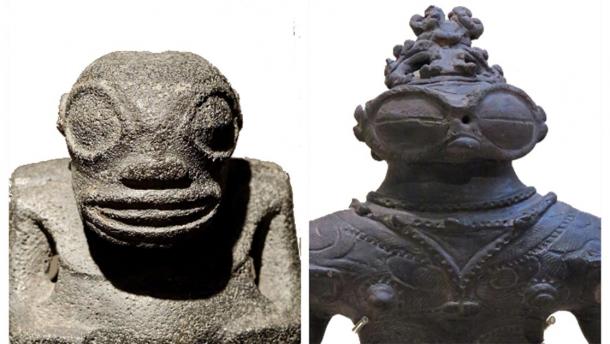
A side-by-side comparison of two sculptures, separated by vast expanses of turbulent ocean. To the right, the “goggle-eyed” dogu from Kamegaoka, late Jomon period (1,000- 400 BC) (CC BY SA 4.0) and to the left, a Tiki sculpture found in the Marquesas Islands, French Polynesia (Public Domain).
Admittedly, the similarity is small. But given everything else we know about newly understood migration patterns and advanced ancient mapping, I decided to pursue it further. Could exploring the history of the Tiki help provide some clarity?
I contacted an Oceanic Art specialist and, while I’ll omit his name, I can say that he works for a very prestigious and long-lasting antique auction house and dealership business. Among a multitude of interesting things, he pointed out that there is a considerable “...lack of historical material documenting the precise provenance” regarding these (Tiki) sculptures.”
“Most of these objects have been collected randomly… without any written documentation [and] arrived in Europe in the late XIXth century” he went on to tell me, ending his correspondence by making clear that we should “not exclude them from being older than from this time.” Thus, just like the dogu, we are left rather unsure as to where, when, or why these Tiki sculptures appeared in the Pacific Islands.
Could there have been some sort of oceanic connection between Japan and Polynesia that spread this style? Could it have come from one single, ancient source?
A 2012 study of edge-ground axe heads in Japan, dating to 38,000 - 32,000 years ago (Takashi, 2012, Pp. 70-78) certainly highlights the fact that, due to the heads being created from obsidian, a material only found on the island of Hokkaido, the earliest humans in Japan would have enjoyed access to sea-faring crafts which allowed them to process this sought-after material.

An Ainu man, one of Hokkaido's indigenous people. (Public Domain)
The distances would have started small but, according to archaeologists Glascock and Kuzmin, they eventually rose to over 1000 kilometers (621.37 miles) during the Upper Paleolithic (around 50,000-10,000 years ago) (2007, Pp. 99-120).
While this is not conclusive proof that Japanese islanders were in contact with South Pacific populations or vice versa, the possibility of some form of prehistoric connection should not be readily dismissed.
Further Afield
The intrigue continues when we learn that this superficial artistic link does not just stop with these Pacific cultures. I have also noticed a similarity between various dogu sculptures and figures found in the Lepenski-Vir archaeological site. This is located all the way to the west, a journey of, as the crow flies, over 8,000 km (4970.97 miles) in modern day Serbia.
From Ph.D. research in the Department of Archaeology within the University of Cambridge, Dr. Borić claims the Serbian site dates back to 8,200 BC (2002, p.1030) and the so called “Progenetrix” sculpture is from the 7,000 BC strata - well within the Jomon time period.
Obvious similarities arise:
- The facial expressions - notably exhibiting a look akin to “shock” or “surprise.”
- The small, circular, ringed eyes, both seeming to be deliberately depicted looking up.
- The rounded, triangular shape of the face.
- The geometric-style pattern engraved around the body.
- The position of the hands - seeming to curl inwards, resting on the torso.
With the notion that the Japanese Jomon period lasted for close to 14,000 years, the possibility that they were in contact with areas as far out as Polynesia or Serbia does not seem too crazy.
Considering nothing is really discussed about this in the local records, this also opens up the possibility that they were in fact not the originators of this connection, but simply part of the instance of locals being contacted by other civilizations, yet unknown, who also traveled west across Eurasia, eventually to Serbia during the Lepenski-Vir period, and also south-east by means of oceanic voyage down to the Pacific Islands.
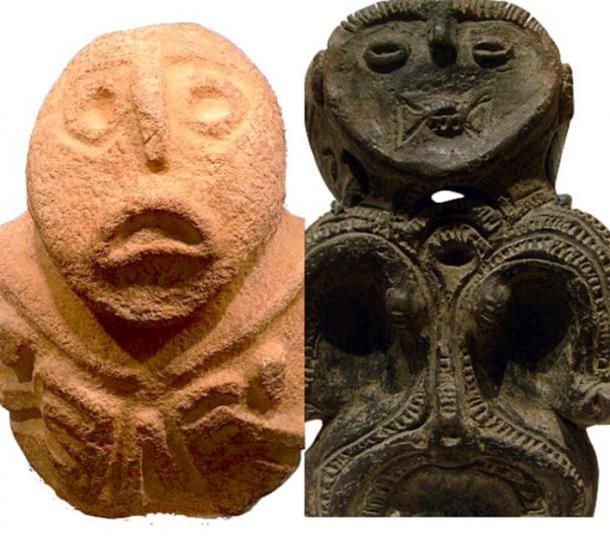
The Lepenski-Vir “Progenetrix” figure to the left (CC BY SA 4.0) and its dogu counterpart to the right. (Public Domain)
Questions Remaining about Early Transoceanic Voyages
Seeing as it’s almost a given that ancient civilizations were traveling the world, via our oceans, long before the uncompromising waves of Europeans broke over the distant shores, this leaves the question very much open for when the earliest examples of sea-exploration were.
- Antarctica's Ancient Origins Update – Part Two: Did Early Voyagers Leave Evidence?
- The Legend of How Mansa Abu Bakr II of Mali Gave up the Throne to Explore the Atlantic Ocean
What does this mean for the origins of advanced sea faring civilizations?
Who could have been at the genesis of this oceanic expansion?
I find the question of whether these ancient maps really did find themselves beginning with someone who was staring at the Antarctic coast, ice-free, armed with the tools and knowledge necessary to illustrate precise maps of what lay in front of them, many thousands of years ago, highly compelling.
Were these the same people who then proceeded to systematically visit and embed themselves among emerging ancient cultures all over the world?
The only way to find out is to keep searching for answers - some will be a lot deeper than others.
Top Image: Representation of an ancient transoceanic voyage. Source: pawopa3336 /Adobe Stock
By Freddie Levy
References
Anderson, A., Chappell, J., Gagan, M., & Grove, R. 2006. Prehistoric maritime migration in the Pacific islands: an hypothesis of ENSO forcing in The Holocene. 16 (1), P. 1. [Accessed: https://doi.org/10.1191/0959683606hl901ft]
Barnes, S.S. et al. 2006. Ancient DNA of the Pacific rat (Rattus exulans) from Rapa Nui (Easter Island) in Journal of Archaeological Science. [online]. 33 (11). Pp. 1536–1540
BBC. September 21, 2018. Prehistoric art hints at lost Indian civilisation. [Accessed: https://www.bbc.co.uk/news]
Borić, D. 2002. The Lepenski Vir conundrum: Reinterpretation of the Mesolithic and Neolithic sequences in the Danube Gorges in Antiquity. 76 (294), Pp. 1026-1039. [Accessed: http://orca.cf.ac.uk/39454/1/Antiquity-2002.pdf]
Clarkson, C et. al. 19 July 2017. Human occupation of northern Australia by 65,000 years ago in Nature. 547 (7663): 306–310. [Accessed: https://digital.library.adelaide.edu.au/]
Connor, S. October 23, 2014. New discoveries show more contact between far-flung prehistoric humans than first thought in The Independent [online]. [Accessed: here]
Cotterell, M. 2003. The Lost Tomb of Viracocha: Unlocking the Secrets of the Peruvian Pyramids. New York: Simon and Schuster.
Glascock, M. D. Kuzmin, Y. V. 2007. Two Islands in the Ocean: Prehistoric Obsidian Exchange between Sakhalin and Hokkaido, Northeast Asia in The Journal of Island and Coastal Archaeology. 2.1. Pp. 99-120.
Hancock, G. 2015. Magicians of the Gods. United Kingdom: Coronet.
Hapgood, C. H. Maps of the Ancient Sea Kings. Philadelphia and New York: Chilton Books, 1966, P. 243.
James, V. October, 2009. The dogu have something to tell us in The Japanese Times. [Accessed: https://www.japantimes.co.jp/culture/2009/10/02/arts/the-dogu-have-something-to-tell-us/#.XlTD8JNKjOR]
Malaspinas, A. S. et al., November 3, 2014. Two ancient human genomes reveal Polynesian ancestry among the indigenous Botocudos of Brazil in Current Biology 24/21, Pp. R1035-R1037
Matisoo-Smith, E. Robins, J. H. June, 2004. Origins and dispersals of Pacific peoples: Evidence from mtDNA phylogenies of the Pacific rat in Proceedings of the National Academy of Sciences, 101 (24) Pp. 9167-9172. (DOI: 10.1073/pnas.0403120101)
Schmidt, G. A., Frank, A. 2018. The Silurian Hypothesis: Would It Be Possible to Detect an Industrial Civilization in the Geological Record? in International Journal of Astrobiology. 18.2: 142–150. [Accessed: https://arxiv.org/abs/1804.03748]
Shortland, E. 1882. Maori Religion and Mythology. Longman, Green: London.
Takashi, T. January, 2012. MIS3 edge-ground axes and the arrival of the first Homo sapiens in the Japanese archipelago in Quaternary International, 248, Pp. 70-78.
van den Hoven, S. 2019. The vedic relations of early religion in India and Europe. [Accessed: https://www.academia.edu]
















Comments
Great suggestion Sigerico!
I've briefly looked through the book before (admittedly it's very dense so was more of a skim) - Higgins' theories were definetely out of the norm for his time, and whilst he is very heavy on the religion-side of analysis, I do find his theory on ancient Chinese and Indian expansion to explain common demoninators in culture and religion compelling.
I tend to lean away from Higgins' view that the similarities in various religious figures is based around the zodiac constellations and that "God" is the sun alone, and I move more towards the theory that these religious characters were based on actual figures who were only immortalised due to their extreme knowledge, albeit it with certain symbology encoded throughout the myth and religion as well.
Your right about navigating without sight of land. Whether by learned esoteric knowledge on how to read and navigate by the stars, to unknown or yet not fully understood technology (take the Antikythera mechanism for example), ancient people could for sure navigate accurately over extreme distances.
Interesting that you think the site of "Atlantis" (basically a lost ancient sea-faring culture mentioned famously by Plato) is in Indonesia. What leads you to those conclusions? I subscribe to Randal Carlson's theory that the ancient sea-faring culture was actually located within the Azores archipelago, off the coast of Portugal. I am always open to other interpretations... Thanks for the comment!
you should read old books like Anacalypsis by Godfrey Higgins, published in 1840. he goes into these transoceanic voyages in ice age times. there was ship traffic across the Indian Ocean in Roman times and earlier. ocean going wooden ships are built to the same design to this day in Kerala.
they were perfectly capable of navigating out of sight of land. that's why there are pyramid cultures all around the world. they were all built by the same people.
the whole world probably had a common culture and language, either Sanskrit or something similar.
Atlantis may have been the origin, most likely on the equator in Indonesia. the Java Sea is only 50 metres deep, so with sea levels being 200 metres lower during the last ice age vast areas of land would have been exposed.